Biology > QUESTIONS & ANSWERS > Chapter 19—VIRUSES, BACTERIA, AND ARCHAEA. All Answers (All)
Chapter 19—VIRUSES, BACTERIA, AND ARCHAEA. All Answers
Document Content and Description Below
1. When a virus takes over the machinery of a cell, it forces the cell to manufacture more: a. mitochondria for energy for the virus. b. liposomes to isolate themselves from water c. food ... particles d. viral particles e. Golgi bodies in order to secrete the excess viruses. d POINTS: 1 REFERENCES: Section 19.1 What are viruses? KEYWORDS: Bloom's: Remember 2. Two methods of reproduction are common for bacteriophages. Which statement best describes the relationship between the two methods? a. Viral DNA reproduced via the lysogenic pathway eventually enters the lytic pathway. b. Viral DNA reproduced via the lytic pathway eventually enters the lysogenic pathway. c. Viral DNA in the lysogenic pathway immediately directs the host to reproduce the new viral particles. d. The lytic and lysogenic pathways cannot interact in bacteriophage reproduction. e. The lytic pathway is dependent upon the lysogenic pathway for infection. a POINTS: 1 REFERENCES: Section 19.1 What are viruses? KEYWORDS: Bloom's: Understand 3. The lysogenic pathway is characterized by: a. integration of viral DNA into the host chromosome b. extensive transcription of viral DNA c. release of phages d. host cell death e. no dormant stage a POINTS: 1 REFERENCES: Section 19.1 What are viruses? KEYWORDS: Bloom's: Remember NOTES: Modified Figure 19.3 Structure of HIV. 4. Refer to the accompanying figure. What viral glycoprotein binds proteins on the host cell to allow entry of the virus? a. A b. B c. C d. D e. E a POINTS: 1 REFERENCES: Section 19.1 What are viruses? KEYWORDS: Bloom's: Remember NOTES: New 5. All viruses have coat proteins that protect their genome. The viral coat is indicated by which letter in the accompanying figure? a. A b. B c. C d. D e. E b POINTS: 1 REFERENCES: Section 19.1 What are viruses? KEYWORDS: Bloom's: Remember 6. The viral envelope is represented by which letter in the accompanying figure? a. A b. B c. C d. D e. E d POINTS: 1 REFERENCES: Section 19.1 What are viruses? KEYWORDS: Bloom's: Remember NOTES: New 7. How does a retrovirus prepare its genetic material for incorporation into the host cell genome? a. Viral reverse transcriptase uses viral RNA to make double-stranded viral DNA. b. Viral reverse transcriptase uses viral single-stranded DNA to make double-stranded viral DNA. c. Viral reverse transcriptase uses viral RNA to make double-stranded viral RNA. d. Host enzymes incorporate viral RNA directly into the genome. e. Host enzymes covert viral RNA to double-stranded viral DNA. a POINTS: 1 REFERENCES: Section 19.1 What are viruses? KEYWORDS: Bloom's: Understand NOTES: New 8. Once retroviral DNA is incorporated into the host genome, what happens to the newly transcribed RNA? a. The RNA is translated into host proteins. b. The RNA is translated into viral proteins. c. The RNA serves as genetic material for new viruses. d. The RNA is reverse transcribed into double-stranded DNA. e. Some is translated into viral proteins and some serves as genetic material for new viruses. e POINTS: 1 REFERENCES: Section 19.1 What are viruses? KEYWORDS: Bloom's: Remember NOTES: New 9. A mosquito becomes infected with West Nile virus and then it bites a human and transfers West Nile virus into the human’s bloodstream. Which organism(s) is the vector in this case? a. human b. mosquito c. bird d. mosquito and bird e. mosquito and human b POINTS: 1 REFERENCES: Section 19.2 How do viruses affect human health? KEYWORDS: Bloom's: Understand NOTES: New 10. The virus known as H1N1 (swine flu): a. has a high death rate b. is seldom transmitted person-to-person c. has no reliable treatment d. has been harnessed by a vaccine e. occasionally infects people who have direct contact with birds d POINTS: 1 REFERENCES: Section 19.2 How do viruses affect human health? KEYWORDS: Bloom's: Remember 11. West Nile virus is transmitted to humans by which vector? a. birds b. cats c. other humans d. mosquitoes e. bacteria d POINTS: 1 REFERENCES: Section 19.2 How do viruses affect human health? KEYWORDS: Bloom's: Remember NOTES: Modified 12. A(n) _____ disease has only recently been detected in humans, or has recently expanded its range. a. emerging b. epidemic c. pandemic d. sporadic e. plague a POINTS: 1 REFERENCES: Section 19.2 How do viruses affect human health? KEYWORDS: Bloom's: Remember NOTES: Modified 13. When two viruses infect a cell at the same time, there is a possibility of gene exchange between the two. This is called: a. gene swapping b. horizontal gene transfer c. viral exchange d. viral recombination e. conjugation d POINTS: 1 REFERENCES: Section 19.2 How do viruses affect human health? KEYWORDS: Bloom's: Remember NOTES: New 14. Viroids differ from viruses in that: a. they lack RNA b. they lack a viral envelope c. they are much larger d. they do not replicate e. viroid RNA does not encode proteins e POINTS: 1 REFERENCES: Section 19.3 How do viruses and viroids affect plants? KEYWORDS: Bloom's: Understand NOTES: Modified 15. The genetic information in viroids is: a. DNA b. protein c. lipid d. RNA e. either DNA or RNA d POINTS: 1 REFERENCES: Section 19.3 How do viruses and viroids affect plants? KEYWORDS: Bloom's: Remember Selecting the Exception 16. Four of the five answers listed below are cellular. Select the exception. a. viroids b. cyanobacteria c. halophiles d. methanogens e. thermophiles a POINTS: 1 REFERENCES: Section 19.3 How do viruses and viroids affect plants? Section 19.5 What are some major bacterial lineages? Section 19.8 Where do archaea live? KEYWORDS: Bloom's: Remember OTHER: Selecting the Exception 17. The process of conjugation is described by four of the five statements below. Select the exception. a. In the process of conjugation, one cell gives a plasmid to another cell. b. Cells get together for conjugation when one cell extends a sex pilus to another cell. c. The cell that made the sex pilus passes a copy of its plasmid to the other cell. d. Conjugation is a mode of cellular reproduction. e. Each cell involved in the exchange can pass the plasmid on to other cells during future gene transfers. d POINTS: 1 REFERENCES: Section 19.4 How are bacteria and archaea similar? KEYWORDS: Bloom's: Remember OTHER: Selecting the Exception 18. Four of the five answers are correct statements about E. coli. Select the exception. a. It grows easily in a laboratory. b. It is a rod-shaped species of proteobacteria. c. It is widely used in industrial biotechnology. d. It is capable of photosynthesis. e. It is a normal inhabitant of the gut. d POINTS: 1 REFERENCES: Section 19.5 What are some major bacterial lineages? KEYWORDS: Bloom's: Remember NOTES: Modified 19. Four of the five answers listed below are bacterial structures. Select the exception. a. cell wall b. pilus c. capsule d. protein coat e. plasma membrane d POINTS: 1 REFERENCES: Section 19.5 What are some major bacterial lineages? KEYWORDS: Bloom's: Remember OTHER: Selecting the Exception NOTES: Modified 20. Four of the five answers listed below are usually considered pathogenic. Select the exception. a. Thermus aquaticus b. Bacillus anthracis c. Mycobacterium tuberculosis d. Clostridium botulinum e. Borrelia burgdorferi a POINTS: 1 REFERENCES: Section 19.6 How do bacteria affect human health? KEYWORDS: Bloom's: Remember OTHER: Selecting the Exception NOTES: Modified 21. Four of the five answers listed below are differences between archaea and bacteria. Select the exception. a. cell wall components b. membrane components c. ribosomal RNA sequences d. DNA nucleotides e. DNA and histone organization d POINTS: 1 REFERENCES: Section 19.7 How were archaea discovered? KEYWORDS: Bloom's: Understand OTHER: Selecting the Exception NOTES: Modified 22. What structure do bacteria use during conjugation? a. pili b. flagella c. ribosomes d. plasma membrane e. no bacterial structure; it relies on viral transfer a POINTS: 1 REFERENCES: Section 19.4 How are bacteria and archaea similar? KEYWORDS: Bloom's: Understand NOTES: New 23. Which bacterial structure is found internally in the cell? a. flagellum b. pilus c. plasmid d. capsule e. cell wall c POINTS: 1 REFERENCES: Section 19.4 How are bacteria and archaea similar? KEYWORDS: Bloom's: Understand NOTES: Modified 24. The process by which one bacterial cell transfers DNA to another is: a. fission b. gametic fusion c. conjugation d. lysis e. fusion c POINTS: 1 REFERENCES: Section 19.4 How are bacteria and archaea similar? KEYWORDS: Bloom's: Understand NOTES: Modified 25. Protective layers outside the bacterial cell membrane include: a. cell walls only b. capsules only c. envelopes only d. cell walls and plasmids e. cell walls and capsules e POINTS: 1 REFERENCES: Section 19.4 How are bacteria and archaea similar? KEYWORDS: Bloom's: Remember NOTES: Modified 26. Which mechanism(s) of obtaining energy and nutrients are only present in bacteria and archaea, but not eukaryotes? a. photoautotrophs b. chemoautotrophs c. photoheterotrophs d. chemoheterotrophs e. chemoautotrophs and photoheterotrophs e POINTS: 1 REFERENCES: Section 19.4 How are bacteria and archaea similar? KEYWORDS: Bloom's: Understand NOTES: New 27. Which group uses light energy to break down organic molecules from their environment? a. eukaryotic photoautotrophs b. bacterial photoautotrophs c. eukaryotic photoheterotrophs d. bacterial photoheterotrophs e. all chemoheterotrophs d POINTS: 1 REFERENCES: Section 19.4 How are bacteria and archaea similar? KEYWORDS: Bloom's: Understand NOTES: New 28. In which type of transfer do bacteria or archaea take up DNA from their environment and integrate it into their genome? a. conjugation b. transduction c. transformation d. all horizontal e. vertical c POINTS: 1 REFERENCES: Section 19.4 How are bacteria and archaea similar? KEYWORDS: Bloom's: Remember NOTES: New 29. These bacteria ferment sugars, produce lactate, and are used for some food production. a. Lactobacillus b. Bacillus c. spirochetes d. Agrobacterium e. cyanobacteria a POINTS: 1 REFERENCES: Section 19.5 What are some major bacterial lineages? KEYWORDS: Bloom's: Remember NOTES: New 30. Which organisms can partner with fungi to form lichens? a. all proteobacteria b. cyanobacteria c. archaea d. Gram-positive bacteria e. spirochetes b POINTS: 1 REFERENCES: Section 19.5 What are some major bacterial lineages? KEYWORDS: Bloom's: Remember NOTES: New 31. Why are bacterial decomposers important? a. Most cause disease. b. They produce spores. c. They fix nitrogen. d. Common in biotechnology. e. They break down complex organic molecules in wastes and remains. e POINTS: 1 REFERENCES: Section 19.5 What are some major bacterial lineages? KEYWORDS: Bloom's: Remember NOTES: New 32. When conditions are unfavorable, some bacteria: a. engage in conjugation b. switch to photosynthesis c. form spores, a resistant resting stage d. become pathogenic e. become nonpathogenic c POINTS: 1 REFERENCES: Section 19.5 What are some major bacterial lineages? KEYWORDS: Bloom's: Remember NOTES: Modified 33. Which category of bacteria provides the greatest benefit to production of crop plants? a. spirochetes b. heat-loving T. aquaticus c. nitrogen-fixing bacteria d. Agrobacterium e. L. acidophilus 34. Which bacteria is a common cause of food poisoning? a. Clostridium b. Helicobacter pylori c. Mycobacterium tuberculosis d. Campylobacter e. Lactobacillus 35. The most common vector-borne bacterial disease in the United States is: a. Lyme disease b. West Nile virus c. tuberculosis d. cholera e. MRSA 36. Shiga toxin is dangerous to humans because it is an _____. a. endotoxin that kills cells b. endotoxin that illicit an immune response c. exotoxin that interferes with protein synthesis by intestinal cells d. exotoxin that disrupts nerve cell function e. exotoxin that can overwhelm the immune response and decrease blood pressure 37. What is one characteristic that archaea and eukaryotes share? a. horizontal gene transfer b. chemoautotrophs c. organize DNA around histone proteins d. multiple plasmids e. similar cell wall components 38. Carl Woese investigated evolutionary relationships among prokaryotes by _____. a. comparing complete genome sequences b. comparing ribosomal RNA gene sequences c. classifying organisms based on metabolic patterns d. protein arrays e. by using newly advanced culture methods to compare organisms 39. Methanogens are classified as ____. a. photoautotrophs b. chemoautotrophs c. photoheterotrophs d. chemoheterotrophs e. chemotrophs 40. The extreme halophiles only survive in environments that are extremely high in: a. acid b. heat c. hydrogen d. oxygen e. salt Figure 19.2 Bacteriophage replication pathways 41. In the lysogenic pathway of the accompanying figure, the viral DNA: a. has been destroyed b. is integrated into the bacterial chromosome c. has been copied and changed to bacterial DNA d. is no longer present e. has been transcribed into RNA 42. Label A and B in the accompanying figure. 43. In the accompanying figure, which pathway is not complete until it enters the other pathway? a. lytic b. lysogenic 44. Put these general events of viral replication in order, from first to last: 1. Viral proteins are produced in host cell. 2. Virus attaches to membrane proteins of host cell. 3. Host cell transcribes viral genes. 4. Viral genome enters host cell. 5. Viral components self-assemble. 6. New virus leaves host cell. 45. What letter in the accompanying figure corresponds to each of the following? 1. ____ pilus 2. ____ capsule 3. ____ cell wall 4. ____ plasma membrane 5. ____ flagellum 6. ____ cytoplasm 7. ____ DNA in nucleoid 46. If viruses are not considered to be alive, how can they evolve by natural selection? 47. What is the source of the envelope in enveloped-viruses? 48. How do viruses and viroids differ? 49. What is the main difference between pathogenic bacteria, pathogenic viruses, and viroids. 50. How did the process of viral recombination produce a new subtype of H1N1 influenza virus in 2009? 51. How do plant and animal viruses differ in their mode of entry into host cells? 52. Which two molecules—crucial to life on Earth—do cyanobacteria provide? 53. What are the differences between archaea and bacteria? 54. How does the ability of bacteria to acquire new genes affect antibiotic resistance? 55. Normal bacteria flora are sometimes disrupted by antibiotics. Describe the role of lactobacilli as a normal flora and how its disruption can cause problems. 56. Describe archaea methanogens. Match each term with the best description. a. emerging disease b. bacteriophage c. vector d. retrovirus e. pathogen f. viroid REFERENCES: Section 19.1 What are viruses? Section 19.2 How do viruses affect human health? Section 19.3 How do viruses and viroids affect plants? KEYWORDS: Bloom's: Understand NOTES: New 57. uses reverse transcriptase to produce viral DNA in a host d POINTS: 1 58. virus that infects plants f POINTS: 1 59. virus that infects bacteria b POINTS: 1 60. disease that was previously unknown or is spreading to a new region a POINTS: 1 61. carries a pathogen from one host to the next c POINTS: 1 62. disease-causing agent Choose the most appropriate letter for each. a. used in yogurt production b. soil proteobacteria with a plasmid that gives them the capacity to infect plants and cause a tumor. c. produces deadly toxin d. photosynthetic, oxygen producing bacteria e. produce methane f. can live harmlessly on the skin surface but sometimes infects deep skin layers g. normal inhabitant of the human intestine h. thrive in thermal vents i. one bacteria in this group causes the sexually transmitted disease syphilis REFERENCES: Section 19.5 What are some major bacterial lineages? Section 19.6 How do bacteria affect human health? Section 19.8 Where do archaea live? KEYWORDS: Bloom's: Remember NOTES: New 63. agrobacterium b POINTS: 1 64. Clostridium botulinum c POINTS: 1 65. Lactobacillus a POINTS: 1 66. Escherichia coli g POINTS: 1 67. spirochete i POINTS: 1 68. methanogens e POINTS: 1 69. Staphylococcus aureus f POINTS: 1 70. thermophiles h POINTS: 1 71. cyanobacteria d POINTS: 1 Answer the question(s) using the five groups listed below. a. extreme halophiles b. cyanobacteria c. extreme thermophiles d. proteobacteria e. methanogens REFERENCES: Section 19.5 What are some major bacterial lineages? Section 19.8 Where do archaea live? KEYWORDS: Bloom's: Remember OTHER: Classification Questions NOTES: New 72. These ancient bacteria produce CH4 as a metabolic byproduct. e POINTS: 1 73. These bacteria thrive in very high temperatures. c POINTS: 1 74. These represent the most diverse bacterial group. d POINTS: 1 75. These bacteria can live in water of very high salt concentration. a POINTS: 1 76. These can participate in nitrogen fixation. b POINTS: 1 [Show More]
Last updated: 1 year ago
Preview 1 out of 19 pages
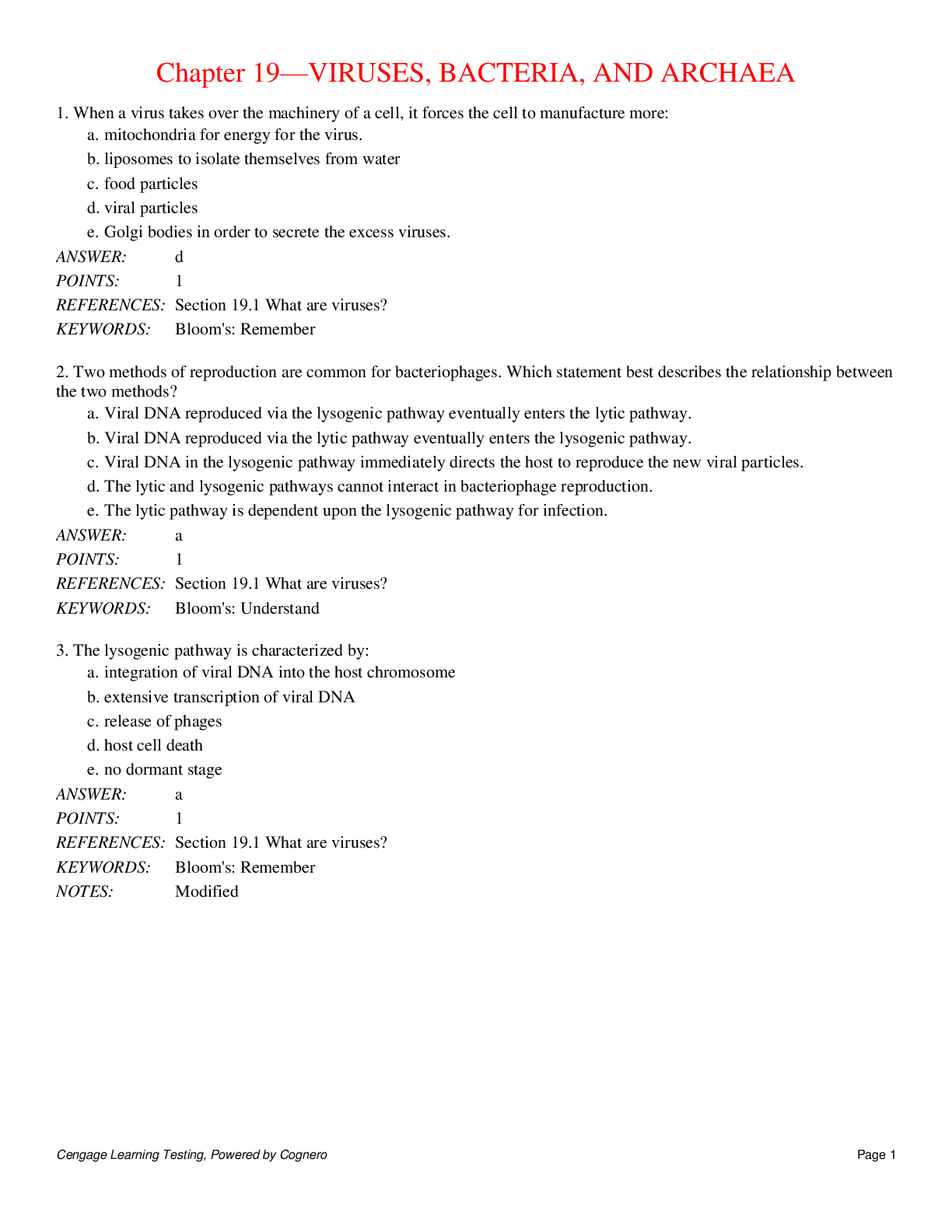
Reviews( 0 )
Document information
Connected school, study & course
About the document
Uploaded On
Nov 27, 2019
Number of pages
19
Written in
Additional information
This document has been written for:
Uploaded
Nov 27, 2019
Downloads
0
Views
60







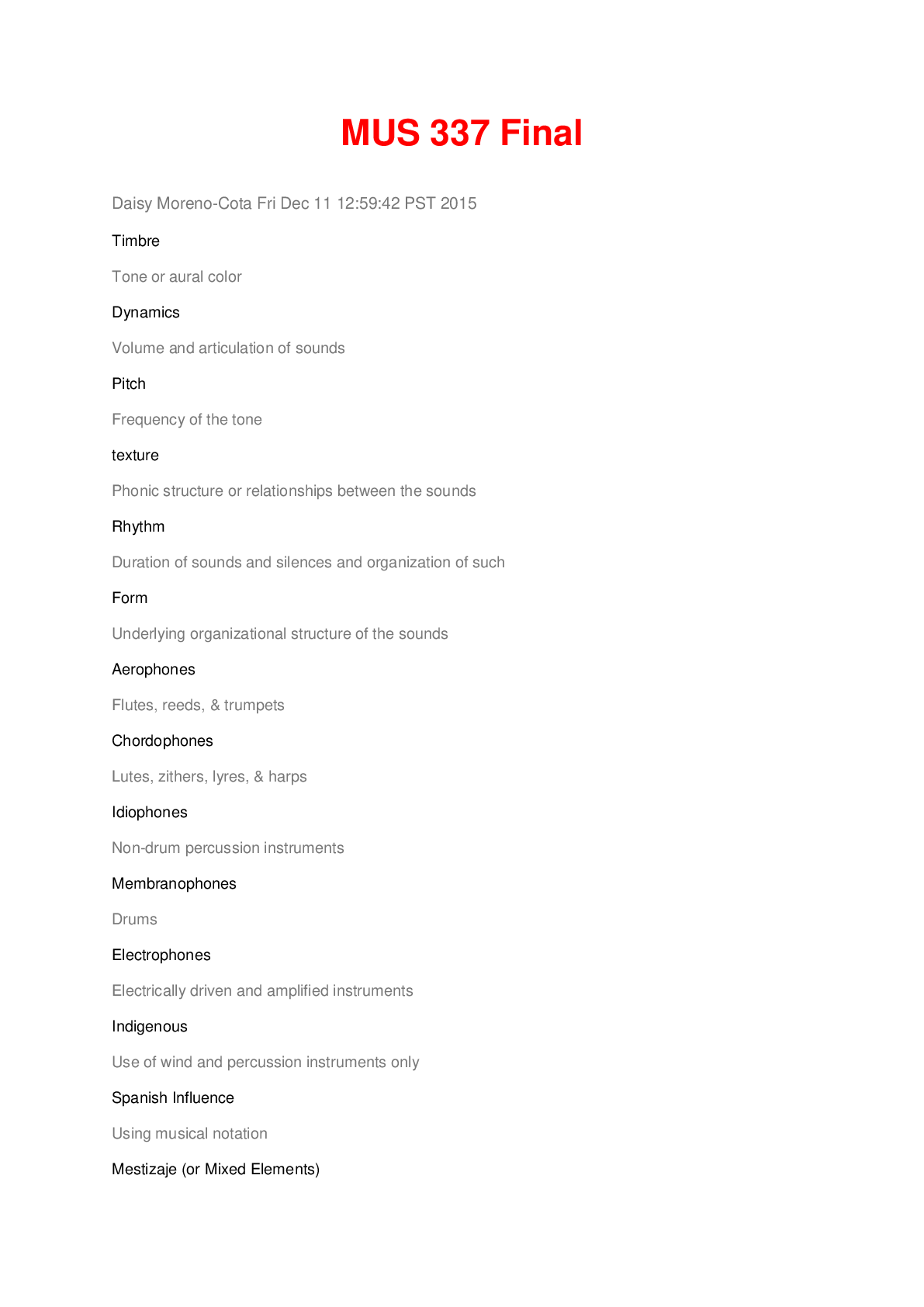




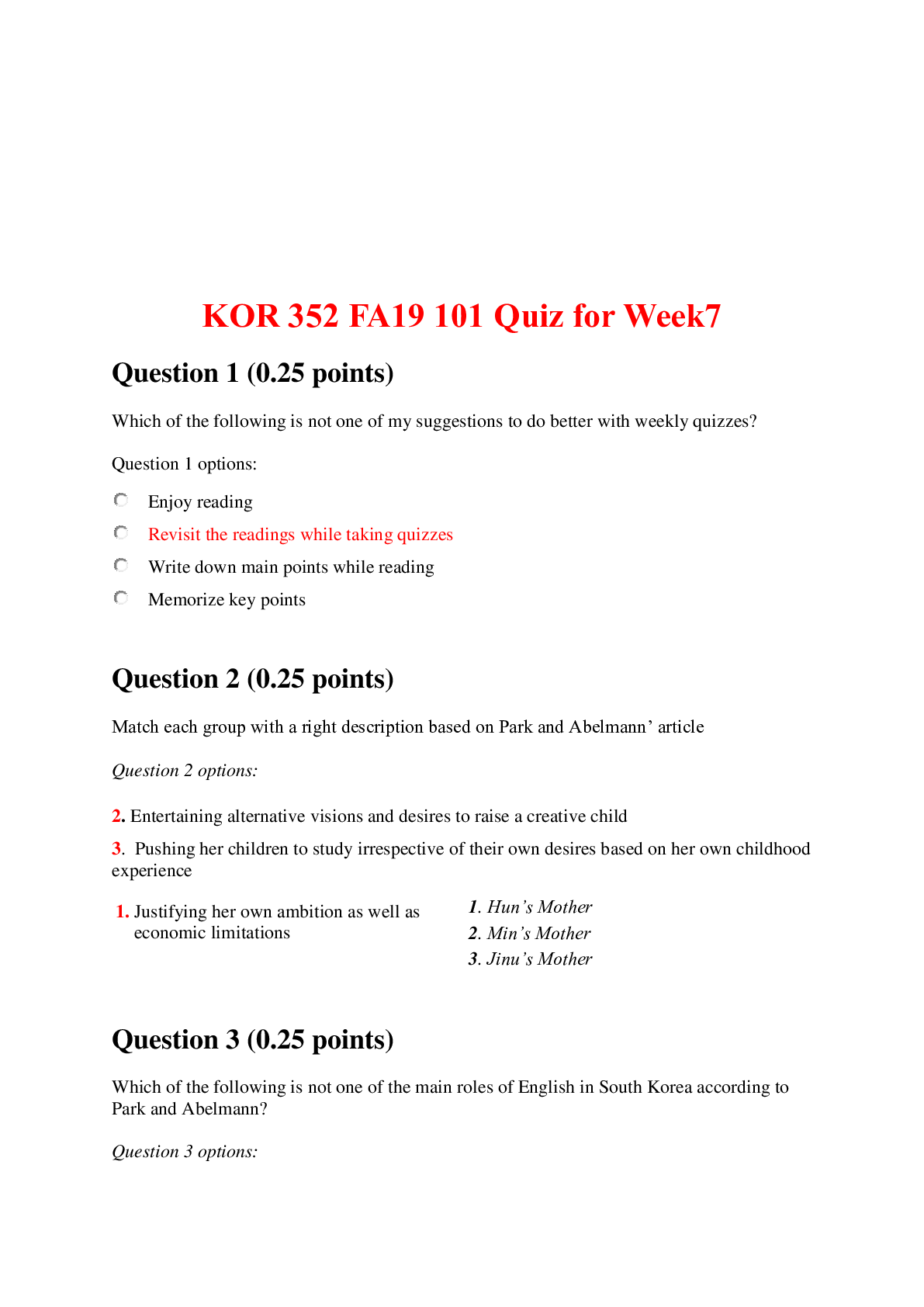


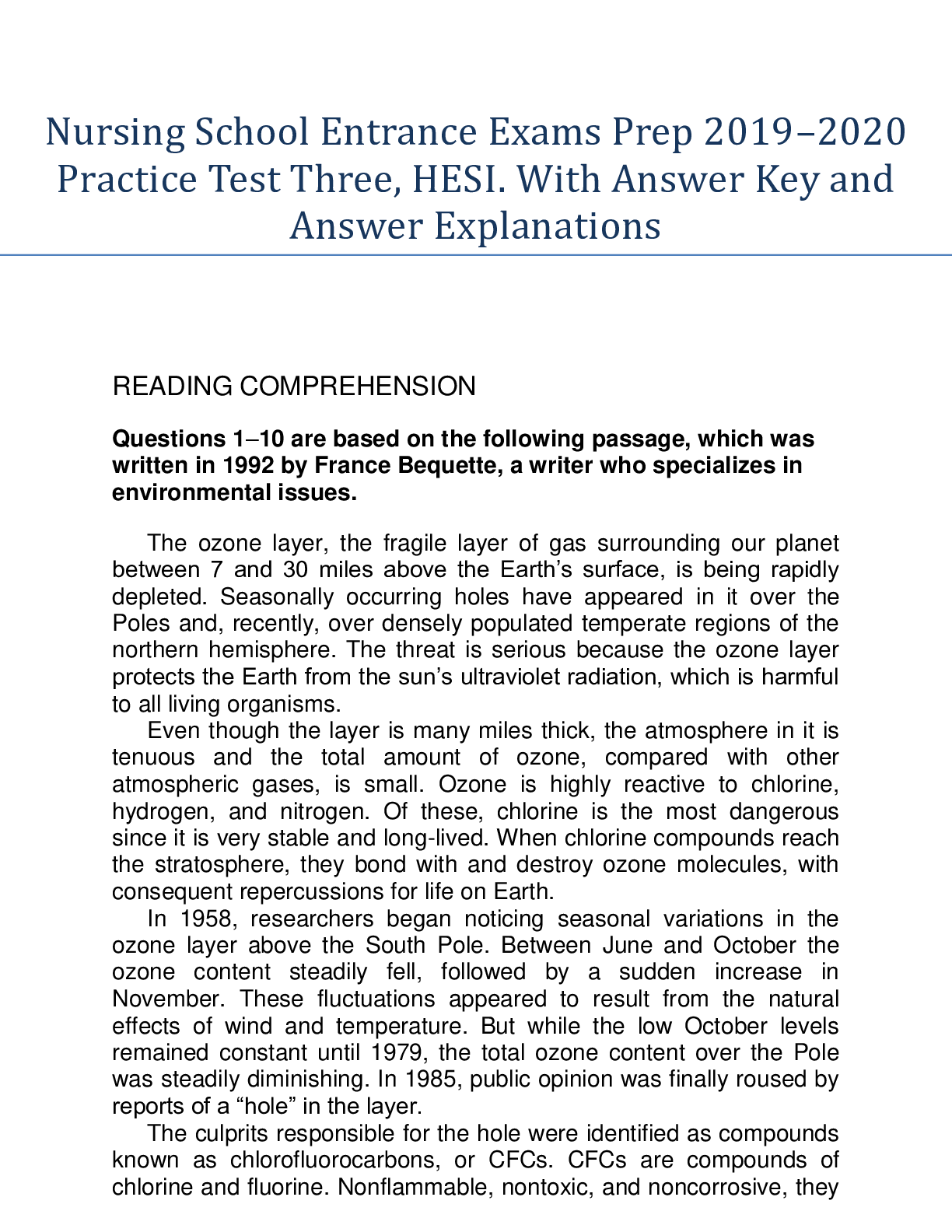


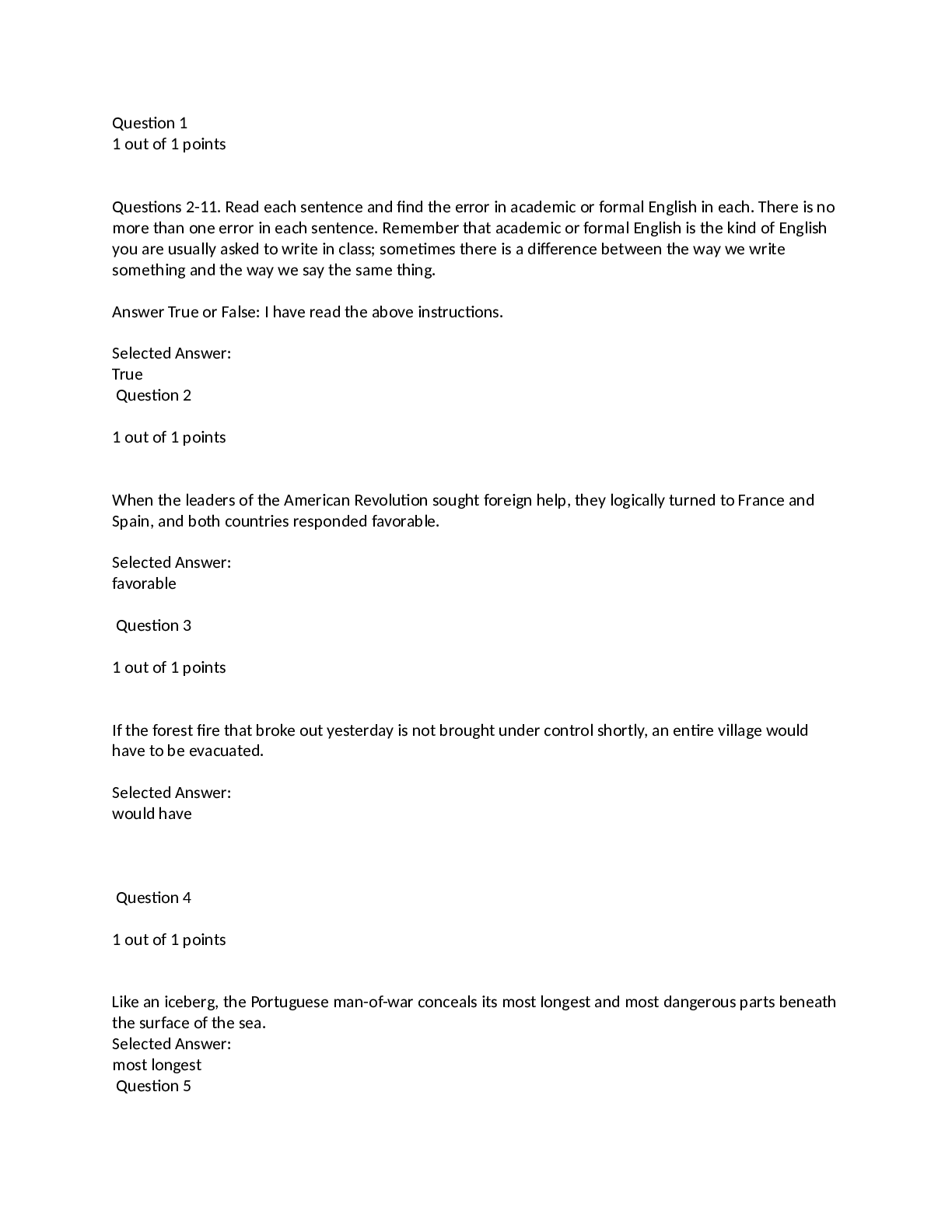
.png)
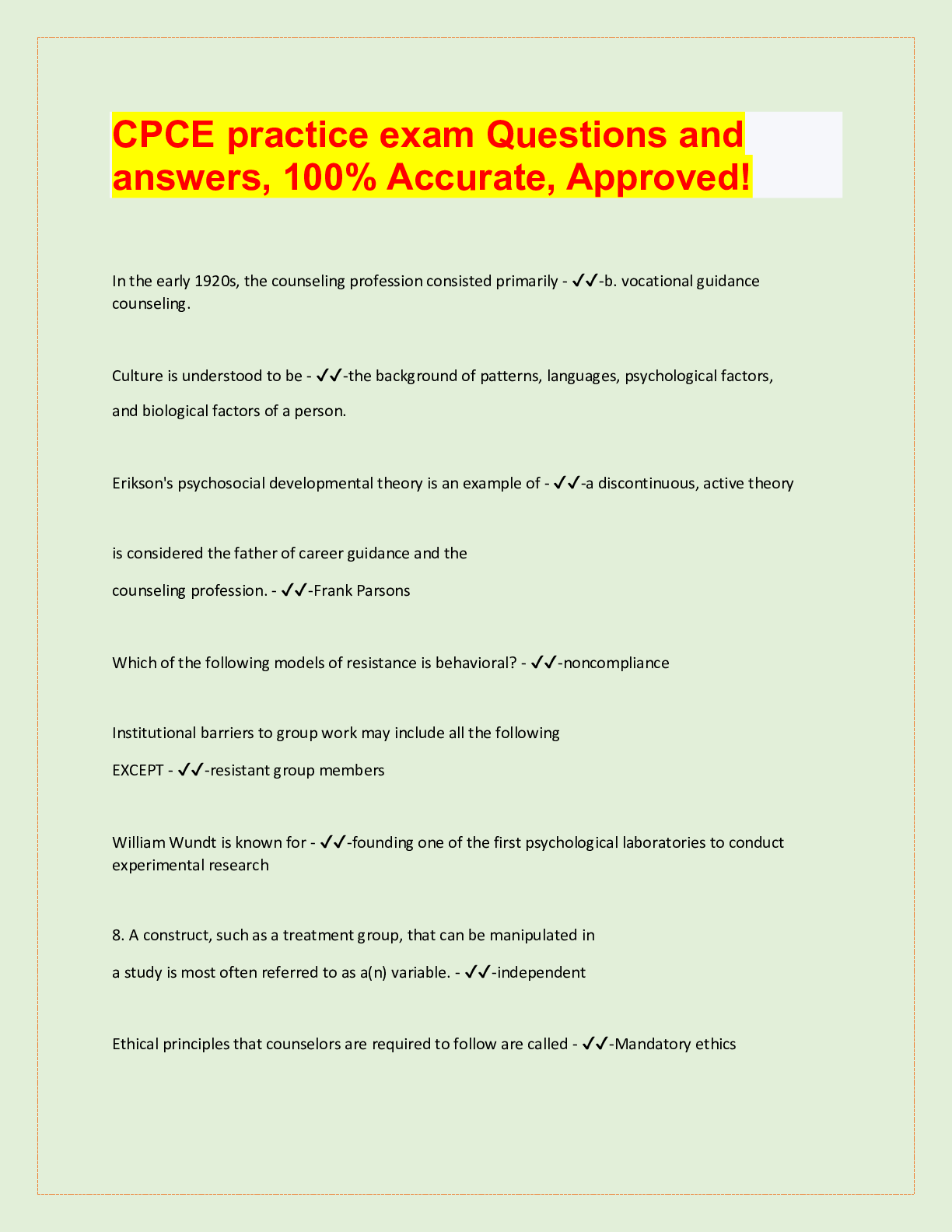
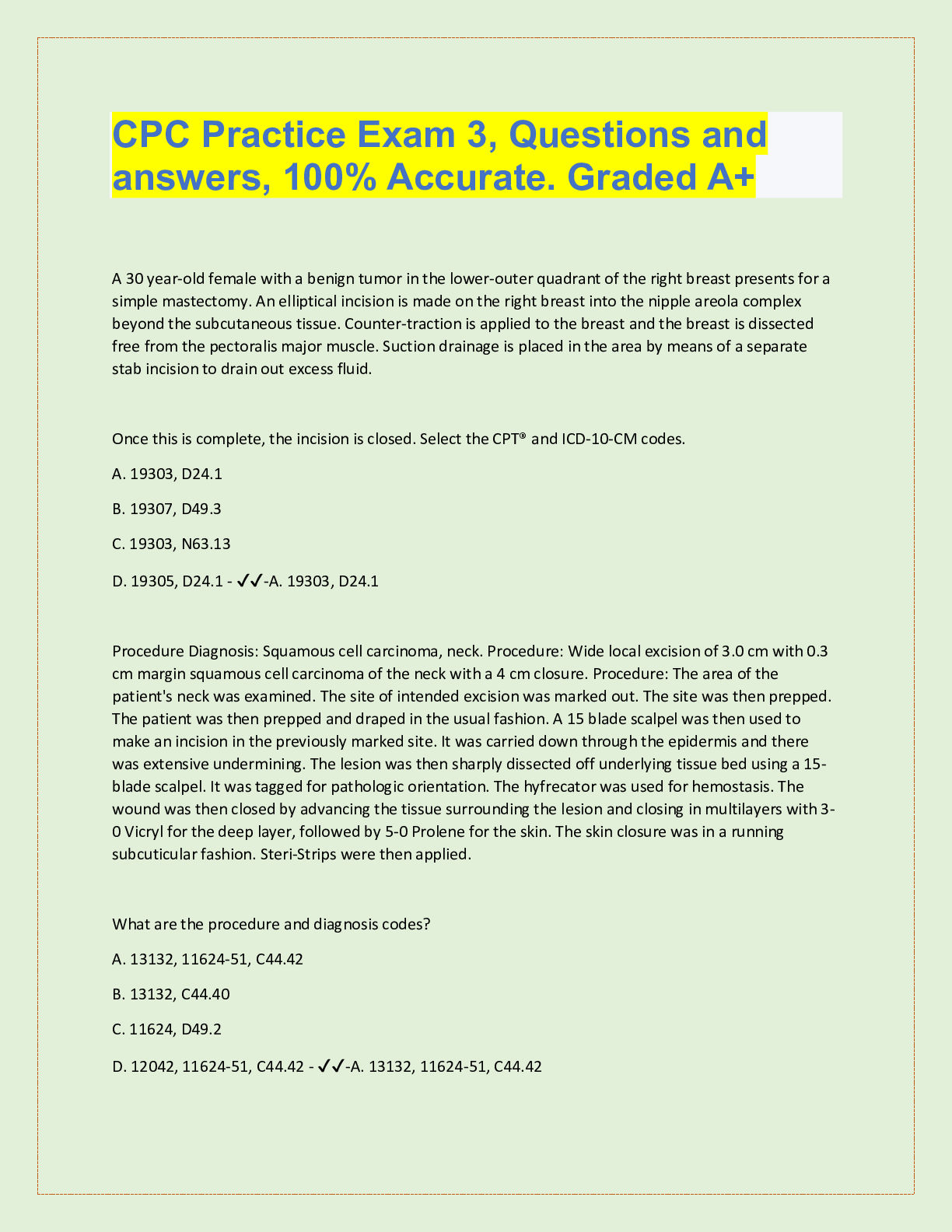
.png)


.png)


.png)

.png)
.png)
.png)


